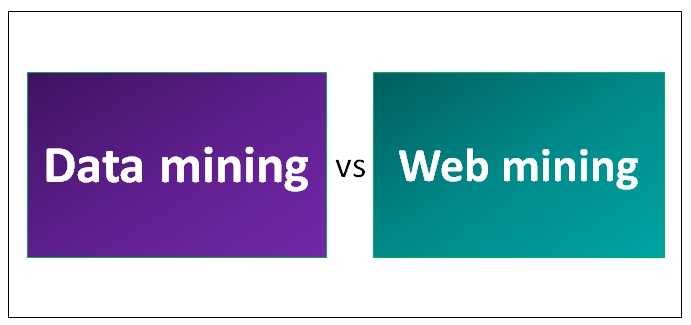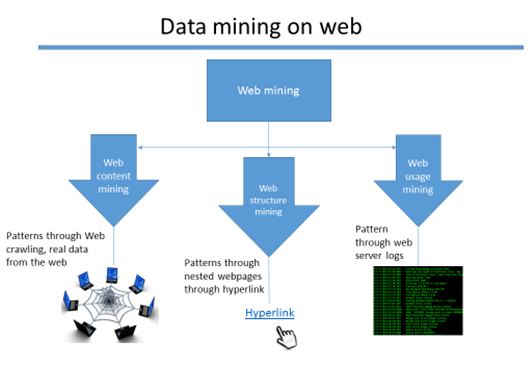Updated April 28, 2023
Difference Between Data Mining vs Web Mining
Data Mining: It is a concept of identifying a significant pattern from the data that gives a better outcome. Identifying patterns from where? From the data that are generated from the systems.
Web Mining: Web mining is performing Data mining on the web, extracting the web documents, and discovering the patterns from them.
Example: Techniques applied for predictive analysis. (Weather forecast based on identifying the patterns from the history data)
Lets us understand the significant Difference Between Data mining and Web mining in detail in this post.
Analogy
The process of gold mining produces gold, which is extracted and refined from ore. The outcome of gold mining is the precious metal. We apply a data mining technique to remove key information (valuable data) from a raw source. Here the pattern discovered from the raw data source is considered precious for the data analyst/data scientists to proceed with the decision-making that influences the business value.
Data Mining
In plain terms, data mining is a concept of mining knowledge from different data sets. We further use the extracted knowledge to provide forecasts or recommendations. The data to be mined are available in the data warehouse or other external systems. Data could be available on different tables with different behaviors or attributes. We must determine the correlation between multiple data sets to identify the pattern.
Steps in Data Mining:
As data mining is an abstract, here are the steps involved:
- Data preparation
- Pattern discovery
- Build models to forecast/recommend(to mention a few cases)
- Summarizing the model value
Web Mining
Web mining is abstract as there are three different types of techniques of mining.
- Web content mining
- Web structure mining
- Web usage mining
Web mining classes of information gathering
1. Web Content Mining
Extracting data from web pages enables discovery of patterns that provide valuable insights. Many data extraction techniques are available, including web scraping, which involves using tools like Scrapy and Octoparse for web content mining.
One of the best examples is–To conduct an event or any program, the organization first analyzes the locations (which location is best suited to run the program so there will be total attendance). To perform these analyses, one has to gather location-specific information about the city, state, and how far the event from the invitee it’s location. We can extract location-specific data from the web.
That’s where web content mining comes into the picture.
2. Web Structure Mining
We gather and prepare data from hyperlinks that lead to different pages to discover a pattern. To view a person’s public profile from a blog or any other webpage, there are chances that they would embed their social media links. We extract data from a single source and its nested pages by following the hyperlinks associated with each page. There are various algorithms to perform this. (Example: PageRank algorithm)
3. Web Usage Mining
Hosting a web application generates numerous web server logs that record the user’s web activity for the application. These logs are considered raw data. In return, meaningful data are extracted, and patterns are identified. For example, if an e-commerce business wants to expand or enhance the customer experience, they monitor the user’s web activity through application logs and apply data mining techniques.
Web mining and data mining are more or less similar techniques, but web mining is all about analysis on the web. Data mining extends beyond the web and is not limited to web data. It’s a traditional process that takes place for any data analytics.
Talking about the data from the web, there are varieties of data that can be observed. Data mining can also involve structured data, such as pulling database data through an API if it is publicly available. Semi-structured data – any web activity related or even server logs pull. Or even unstructured data like images etc. (if any analyses are performed on images)
Head-to-Head Comparison Between Data Mining vs Web Mining (Infographics)
Below are the Top 7 Comparisons Between Data mining vs Web mining:
Key Differences Between Data Mining vs Web Mining
The following is the difference between Data mining vs Web mining are as follows:
- Web mining and data mining are both nearly similar when it comes to identifying patterns. But where and what is the difference in web mining from data mining? What kind of data and data is extracted from where? These are the two ultimate aspects that differentiate between data and Web mining.
- Data mining encompasses web mining, which focuses on identifying patterns in web-related data. Data mining is a vast concept that involves multiple steps, from preparing the data to validating the results that lead to the decision-making process for an organization.
Data Mining vs Web Mining Comparison Table
Below is the comparison table between Data Mining and Web Mining.
| Basis for comparison | Data Mining | Web Mining |
| Concept | Pattern identification from data available in any system. | Pattern identification from web data. |
| Application/use cases | Weather forecast using historical weather reports. | Data crawling HITS/PageRank techniques. |
| Who does this? | Data scientists, Data engineers. | Data scientists/Data analysts Data engineers. |
| Process | Data extraction -> Pattern discovery -> Develop the feature/solve it (Algorithm) | Same process but on the web using web documents. |
| Tools | Machine learning algorithms. | Scrappy, PageRank, Apache logs |
| How significant | Many organizations are relying on data science results for decision-making. | Web-related data pull would influence the existing data mining process. |
| Skills | Data cleansing techniques, machine learning algorithms, statistics, probability. | Application-level knowledge, Data engineering, statistics, probability. |
Conclusion
Data mining techniques enable the discovery of valuable knowledge and facilitate its application for better outcomes. Organizations keen on enhancing their businesses and making a high profit need many decisions based on the data mainly available in their systems generated in humongous volume. Not all data is deemed helpful in gaining knowledge and insights. Which, why, and what are the main questions data scientists/data analysts must consider when identifying patterns? In a very layman’s terms, data mining is like churning milk to make butter.
Recommended Articles
This has been a guide to Data Mining vs Web Mining. Here we have discussed Data Mining vs Web Mining head-to-head comparison, key differences, infographics, and a comparison table. You may also look at the following articles to learn more –





